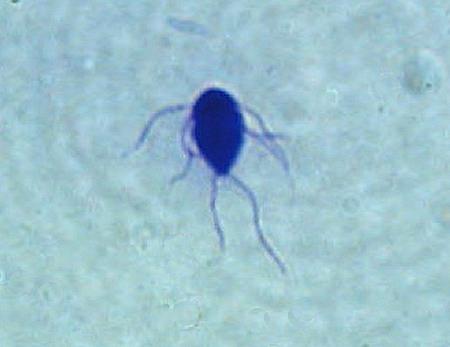| Back to Back Issues Page |
 |
|
The Goldfish Gazette, Issue #112 Treating Hexamita April 28, 2023 |
Goldfish Care TipsA Free Monthly Resource For Goldfish Enthusiasts In This Issue Hexamita is a tiny flagellated protozoan parasite, far smaller than Costia. It is blamed for various fish illnesses such as hole in the head disease, bloat and wasting disease. Hexamita Parasite
The reason I have focused on Hexamita is because the information on the Internet and in publications regarding causes and symptoms is very confusing. Examples of this include;
Symptoms of HexamitaSymptoms depend on what information you are reading.Dr Eric Johnson DVM, eminent Koi and Goldfish specialist, states the fish will be lethargic, with significant erosion of the fins and skin, with the body becoming entirely milky and the protective slime coming off in strands. The fins will appear to have the tissue between the rays being eaten away. The Aquariumscience.org website lists symptoms as white poop, bloat, hollow belly, wasting disease and a lack of appetite. The be.chewy.com website includes white, stringy feces, subdued coloration, loss of appetite and emaciation. Often lesions appear on the fish’s head and sometimes on the fish’s flanks. The www.tankarium.com website symptoms include pits in the head and inflamed lateral line pores, clearly associating Hexamita with HITH disease. Causes of HexamitaThere is generally some consensus regarding the cause of Hexamita, poor environmental conditions the fish is living in leading to a weakened immune system that allows Hexamita to overwhelm the fish.Nothing new here, Hexamita appears to be just another opportunistic pathogen. Treatments for HexamitaThere is also consensus here that the medication to use is Metronidazole (trade name Flagyl), which may not be available in some countries.Another problem is that there is no consensus on how it is to be administered. Dr Eric Johnson’s treatment requires moving the affected fish to a 10 gallon hospital tank and adding 2 250 milligram tablets of Flagyl to the tank every third or fourth day for three treatments. This method appears to assume Hexamita is an external parasitical problem. Other websites also give this as a treatment option if the fish has stopped eating. The problem with this is, the majority of scientific data states that Hexamita is an intestinal parasite. Just because it is sometimes found in HITH lesions doesn’t prove that it caused the lesions. If a fish was expelling large quantities of the protozoa into its water, it is entirely possible that some would be found in the lesions. Most websites suggest treatment by feeding medicated gel food if the fish is eating. If the fish is not eating, the Aquariumscience.org website offers a couple of alternatives such as using a pipette down the fish’s throat, or using Epsom Salts to flush enough of the Hexamita out of the intestines of the fish so that it has a chance to recover. SummarySince the aquatic community can't seem to be consistent about what Hexamita is or its treatment, here is my summation of the disease.Hexamita isn’t a common disease in Goldfish, but it is just one of many opportunist parasites that attack our Goldfish when their immune systems are weakened. It is an intestinal parasite that can also be found externally on the fish. The disease has many symptoms including lethargy, white poop, bloat, hollow belly, wasting disease and a lack of appetite. It may be present at the same time as HITH lesions and inflamed lateral line pores, but it doesn't cause them. Treatment requires feeding medicated food. I suggest adding Metronidazole to the water won’t do any harm, and would kill any free-floating parasites. (Salt at 0.3% strength would probably do the same thing).
Comments? Ideas? Feedback? I'd love to hear from you. Just reply to this e-zine and tell me what you think, or what topics you want to be covered. Next Month's Topic Un-bagging new fishwww.facebook.com/aboutgoldfish |
| Back to Back Issues Page |
